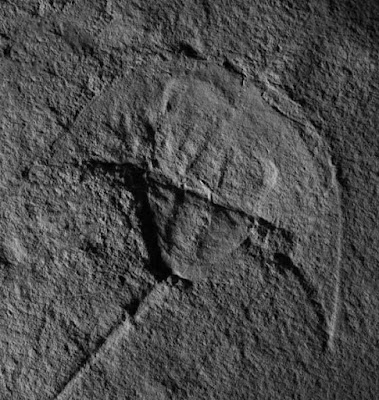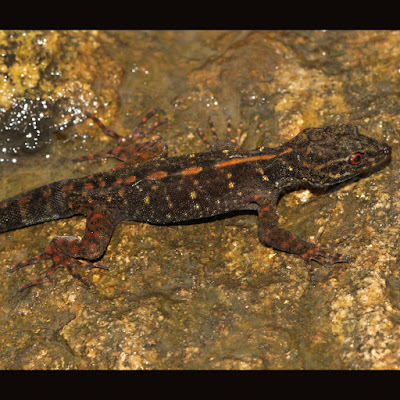[Most Recent Entries] [Calendar View]
Friday, August 17th, 2018
| Time | Event | ||||
| 4:07a | [Paleontology • 2017] Vaderlimulus tricki • First Fossil Horseshoe Crab (Xiphosurida) from the Triassic of North America
Abstract The fossil record of horseshoe crabs (Xiphosurida) from the Mesozoic of North America consists of only three name-bearing specimens from the Cretaceous. We add to this depauperate record the first report of a horseshoe crab body fossil from the Triassic of North America. It comes from a locality in the Olenekian (Spathian) Thaynes Group, near Paris, Idaho, USA. This mostly complete and moderately well preserved specimen is assigned to the family Austrolimulidae Riek, 1955 as Vaderlimulus tricki, n. gen., n. sp.Vaderlimulus is the second austrolimulid taxon to be reported from the Mesozoic of North America. Its discovery adds a fourth austrolimulid genus to the global Triassic fossil record. Vaderlimulus had large genal spines that are most comparable to the Early to late Middle Triassic austrolimulid genera Psammolimulus (Spathian) and Austrolimulus (Ladinian). Heightened enlargement and proportional reduction of body elements, sometimes resulting in bizarre forms, is seen throughout the biostratigraphic range (Serpukhovian-Maastrichtian) of the Austrolimulidae. The discovery of Vaderlimulus provides additional fossil evidence of this evolutionary process. Vaderlimulus likely inhabited a shallow, possibly transitional freshwater coastal setting in the Moenkopi depositional basin along the western Pangean coastal margin. Keywords: Thaynes group, Horseshoe crab, Vaderlimulus, Idaho, Olenekian, Triassic, xiphosurida, Austrolimulus, spathian, Austrolimulidae, Psammolimulus
Subphylum Chelicerata Heymons, 1901 Order Xiphosurida Latreille, 1802 Suborder Limulina Richter & Richter , 1929 Family Austrolimulidae Riek, 1955 Genus Vaderlimulus nov. Etymology: The generic name Vaderlimulus is suggested by a resemblance of the holotype prosoma to the helmet worn by Darth Vader, a well-known fictional character from the Star Wars film series. Vaderlimulus tricki sp. nov. Etymology: The trivial name tricki was chosen in recognition of Trick Runions of the Dinosaur Trackers Research Group, University of Colorado at Denver, who collected the holotype specimen and made it available for study. Allan J. Lerner, Spencer G. Lucas and Martin Lockley. 2017. First Fossil Horseshoe Crab (Xiphosurida) from the Triassic of North America. Neues Jahrbuch für Geologie und Paläontologie - Abhandlungen. 286(3); 289 - 302. DOI: 10.1127/njgpa/2017/0702 | ||||
| 10:29a | [Herpetology • 2018] Cnemaspis anamudiensis & C. maculicollis • Two New Species of Cnemaspis Strauch, 1887 (Squamata: Gekkonidae) from the Western Ghats of Kerala, India
Abstract Two new species of geckos of the genus Cnemaspis Strauch, 1887 are described from the southern Western Ghats of Kerala. Both species are medium to large sized Cnemaspis and can be differentiated from all other Indian congeners by a suite of distinct morphological characters. Both species are found in the high elevation forests of the two major massifs — Anaimalai Hills and Agasthyamalai Hills and are presently known to have very restricted distributional ranges. The discovery of these novel species highlights the understudied diversity of reptiles in the high mountain ranges of the Western Ghats. Keywords: Reptilia, Cnemaspis, Gekkonidae, new species, southern Western Ghats Cnemaspis maculicollis sp. nov. Etymology: The specific epithet is derived from the Latin word macula meaning spot and collus meaning neck referring to the distinctive necklace like white spots on the nape of this species. Distribution: .... Shendurney Wildlife Sanctuary in Kollam District of Kerala in the Agasthyamalai Hill complex; at an elevation range of 1200–1250 m.
Cnemaspis anamudiensis sp. nov. Etymology: The specific epithet is named after the Anamudi reserve forest in Munnar of Idukki District of Kerala, the type and only known locality for this species. Distribution: ... Anamudi Reserve Forest in the Munnar Forest Division of Idukki District at an elevation range of 1860 – 1900 m. The area is contiguous with Eravikulam National Park and is near Anaimudi peak (2695m ASL), the highest peak in the Western Ghats. Vivek Philip Cyriac, Alex Johny, P.K. Umesh and Muhamed Jafer Palot. 2018. Description of Two New Species of Cnemaspis Strauch, 1887 (Squamata: Gekkonidae) from the Western Ghats of Kerala, India. Zootaxa. 4459(1); 85–100. DOI: 10.11646/zootaxa.4459.1.3 |
| << Previous Day |
2018/08/17 [Calendar] |
Next Day >> |




